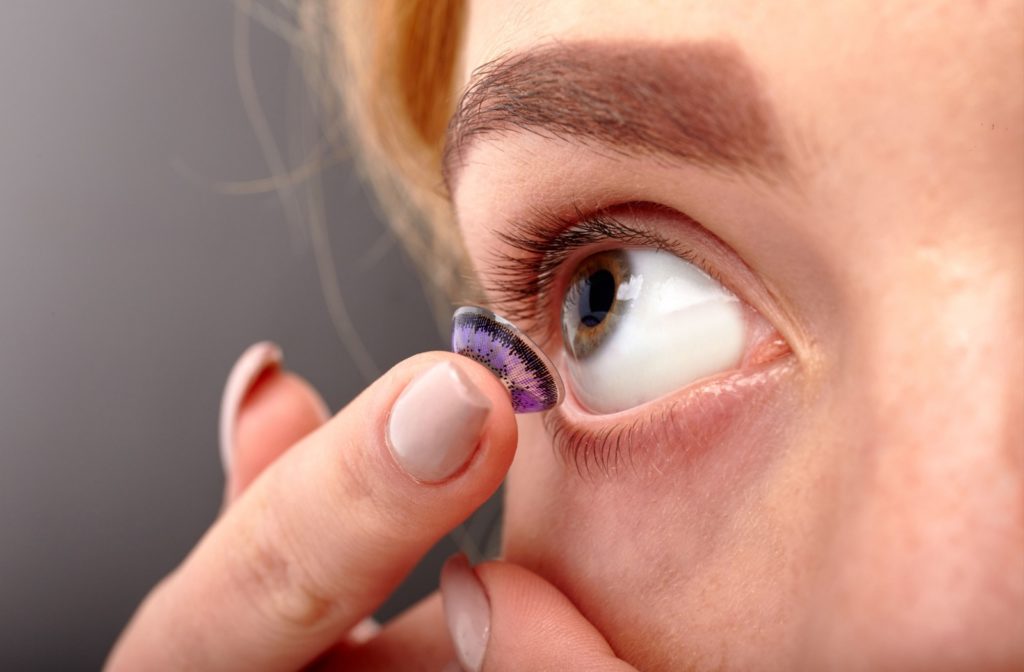Colored contact lenses offer an exciting way to change your look and express your style while providing visual clarity and comfort.
While Colored contact lenses are safe for everyday wear, there are a few factors that users should keep in mind:
- Always purchase colored contacts from your optometrist, as lenses from costume stores can carry safety risks.
- Always follow proper contact lens wear and care standards to reduce the risk of irritation and infection. Never share your colored contacts with others.
Understanding Contact Lenses
Contact lenses are optical devices that sit directly on the eye’s surface to provide clear vision.
Contact lenses correct refractive errors by directly aligning with the curvature of the cornea, helping focus light directly onto the retina.
Contacts are thin, curved, clear lenses that enhance visual clarity. Their lightweight design makes them unnoticeable to the wearer, making them a popular choice for vision correction for those who prefer not to wear glasses.
With several types of contact lenses to choose from, including soft contacts (a popular choice), hard gas-permeable contacts, scleral contacts, and colored contacts, your optometrist will find a lens option most suitable for your visual needs, preferences, and lifestyle.
Contacts provide many benefits but require more maintenance and care than eyeglasses. Adhering to proper contact lens wear and care is essential for comfort, avoiding irritation, and reducing the risk of severe complications.
What Makes Colored Contacts Different?
Colored contact lenses might look like your typical lenses, but they have unique features. Unlike traditional lenses, colored contacts have a tint that masks your natural eye color. This tint can range from subtle enhancements to dramatic changes, allowing the wearer to change their appearance.
The added pigment layer can affect the feel and comfort of a lens.
Some users may notice a slight difference in thickness or rigidity compared to traditional soft lenses. However, with proper contact lens fitting and care, wearers may find them just as comfortable as traditional soft contacts.
Safety is a valid concern for anyone considering colored contact lenses.
The good news is that, when used correctly, colored contacts are generally safe. They’re held to the same stringent standards as regular contact lenses—provided they are sourced from reputable manufacturers.
Due to their fashion-forward nature, colored contacts are sometimes sold without valid prescriptions, usually from costume stores. This is where the risk lies. Non-prescription lenses can be of poor quality and may not fit properly, leading to discomfort and potential eye damage.
Purchasing colored contacts from your optometrist helps confirm your lenses are safe and comfortable.
Types of Colored Contact Lenses
Colored contact lenses are generally available as soft contact lenses. This is primarily due to enhanced comfort and adaptability provided by soft lenses.
Soft lenses, made from flexible materials, conform to the shape of the eye and allow for better oxygen permeability, which is crucial for maintaining eye health.
While hard and scleral lenses can be produced with colored tints, they’re not commonly marketed or used for aesthetic purposes.
Therefore, for those seeking to enhance or change their eye color for style, soft-colored contact lenses remain the most accessible, popular, and comfortable option.
Colored contact lenses come in various types, catering to different needs and preferences:
- Opaque Lenses: These are designed for a complete color change. They cover the iris entirely, making them ideal for dark eyes.
- Enhancement Lenses: These lenses enhance your eye’s natural color by adding depth and definition. They’re usually translucent and are most suitable for light-colored eyes.
- Visibility Tints: Although not intended for color change, visibility tints make handling lenses easier by adding a light blue or green tint. They don’t alter eye color and are more about function than fashion.

Can Anyone Wear Colored Contacts?
The allure of colored contacts is understandable, as they can add a subtle flair to your appearance. Unfortunately, they may not be ideal for everyone. There are a few factors to consider:
- Eye Health: Individuals with specific eye conditions, such as dry eye syndrome, keratoconus, or severe allergies, may experience discomfort while wearing colored contacts.
- Prescription Needs: Colored contacts come in both prescription and non-prescription forms. Even if you’d prefer to wear non-prescription contacts, consider purchasing them from your eye care provider to preserve and maintain safety and eye health.
- Vision Clarity: The prescription parameters for some colored contact lens brands aren’t as diverse in range compared to their traditional, non-colored counterparts. Have a conversation with your optometrist to determine if your vision needs will be met with colored contacts.
- Sensitivity to Materials: Some people may have sensitivities or allergies to the materials used in contact lenses. If you’ve previously experienced irritation or adverse reactions from other lenses, discuss this with your optometrist before trying colored contacts.
Proper Contact Lens Wear & Care
Wearing colored contact lenses every day can be safe, provided that you adhere to proper wear and care guidelines.
- Hygiene First: Always wash your hands before handling lenses. Clean lenses with the recommended solution and store them in a clean case. Keeping your lenses and hands clean minimizes the risk of infections.
- Follow Replacement Schedules: Adhere to the recommended replacement schedule. Overwearing lenses can lead to discomfort and eye problems.
- Avoid Sharing: This is extremely important when wearing non-prescription contact lenses. Never share your lenses with others. This can transfer bacteria and cause severe eye infections.
Remember to listen to your eyes, it’s healthy to give your eyes a break from contacts. If you experience any discomfort, redness, or vision changes, remove the lenses immediately and consult your optometrist.
Schedule an Appointment
Regular exams and annual contact lens fittings with your optometrist help confirm that your eyes remain healthy while you enjoy the style benefits of colored contacts. Connect with our team at Total Vision Chino Hills to schedule an appointment for your contact lens fitting.





